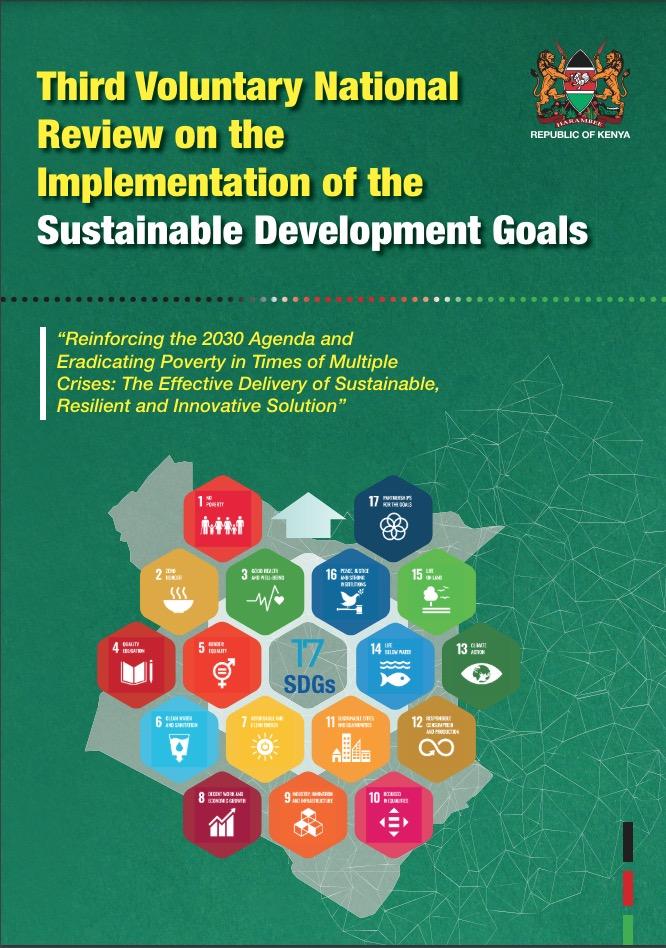Kenya Voluntary National Review 2024
The Kenya 2024 Voluntary National Review (VNR) report presents the progress made in the implementation of the Sustainable Development Goals (SDGs) since the last VNR of 2020, along with the challenges encountered in implementation of SDGs and strategic priorities aimed at accelerating the implementation of SDGs. Kenya conducted its First and Second VNR in 2017 and 2020, respectively. The outlined next steps for enhanced SDGs implementation align with the Bottom-Up Economic Transformation Agenda (BETA), which focuses on economic turnaround and inclusive growth. BETA emphasizes investments in five core strategic pillars: Agriculture; Healthcare; Housing and Settlement; Micro, Small and Medium Enterprises Economy; and the Digital Superhighway and Creative Economy. The preparation of the VNR commenced with the review of the National SDGs Indicator Framework (NIF) in 2023, leveraging on the availability of expanded geospatial, administrative and Citizen Generated Data (CGD), alongside surveys conducted during the review period. The VNR preparation process involved an inclusive, participatory, transparent, and comprehensive review at both national and sub-national levels, engaging all key stakeholders. The stakeholders include: The Public; Ministries, Departments and Agencies (MDAs); Council of Governors (CoG); County Governments; Parliament; the UN Agencies; Private Sector; Civil Society Organizations (CSOs); Media; Research Institutions and Academia, among others. The preparation of the 2024 VNR aligns with Article 74 of the 2030 Agenda that calls for an open, inclusive, participatory, and transparent process in development of the VNR report. Kenya has registered mixed results across the 17 Sustainable Development Goals (SDGs), with some SDGs progressing better than others. The progress reported is based on the 168 indicators in the National SDGs Indicator Framework 2024, which is an increase from 128 indicators in 2016. The 168 indicators constitute 68 per cent of the Global indicators (248). The report indicates that out of the 168 indicators, 60 per cent of the indicators (101) registered positive progress, 12 per cent stalled/stagnated (20), 17 per cent are regressing (28), with progress on 11 per cent of the indicators (19) not discernible due to lack of comparable data. In terms of specific goals, Kenya has made positive progress on all the goals, with some goals progressing better than others. The goals that have registered significant positive progress include SDG3 (Good Health and Well-being), 4 (Quality Education), 5 (Gender Equality), 6 (Clean Water and Sanitation), 7 (Affordable and Clean Energy), 8 (Decent Work and Economic Growth), 11 (Sustainable Cities and Communities), SDG 13 (Climate Action), SDG 15 (Life on Land) and 17 (Partnerships for the Goals). SDG 1 (No Poverty), 9 (Industry, Innovation and Infrastructure), 12 (Responsible Consumption and Production), and 16 (Peace, Justice and Strong Institutions) are progressing at a slow pace while SDG 10 (Reduced Inequalities), 2 (Zero Hunger) and 14 (Life Below Water) are the least progressing. Despite the progress registered, the current pace remains weak and insufficient to achieve any of the goals by 2030. It will, therefore, require the country to redouble efforts to accelerate progress on the goals to increase the chances of achieving the goals by 2030. Specific interventions have been proposed for implementation to accelerate the achievement of the SDGs by 2030.

